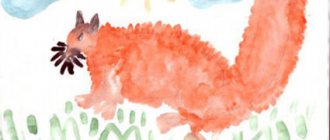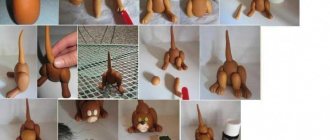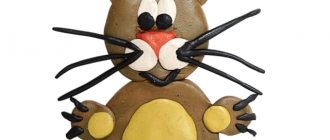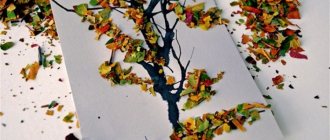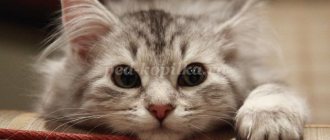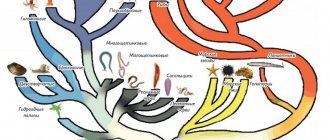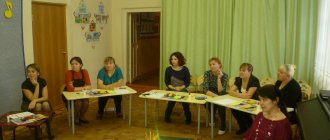Features of appliqué classes in the preparatory group of kindergarten
By the age of 6–7 years, the child handles scissors well and easily cuts out simple shapes along the contour. He can connect dotted lines or dots with a continuous line, and draw simple elements for use in appliqué. In accordance with the skills of pupils of this age, the program requirements become more complex. The teacher needs to direct the children’s imagination to create plot applications. The child should accompany the process of gluing the prepared parts with verbal comments. The game moment turns on: we not only learn how to create a craft, but at the same time we compose a story.
Kinds
Pupils of the preparatory group must master the following appliqué techniques:
- Creation according to the model. The child can trace the templates suggested by the teacher, cut them out and create a picture similar to what they saw. Students are offered several samples on a given topic and are given the opportunity to combine creation techniques and compositional elements.
- Silhouette applique. It involves the same actions as in the previous paragraph, but the template is more complicated, the work turns out to be more labor-intensive and painstaking. For ages 6–7 years, this type of application is interesting when there is a plot-role factor in the creative process.
- Creating a symmetrical figure or a series of symmetrical figures. These are the actions of folding a sheet of paper and cutting out half of the image. For older preschoolers, tasks in this technique should be as complex as possible: the outline for cutting should have nuances, punctures or slits must be made inside the image.
- Broken applique. Used when working in mixed media. For example, in the form of a broken appliqué, an imitation of bird feathers or the fur of fur-bearing animals is created.
- Overlay applique. Also used in mixed media: to depict fish scales, snake skin, bird plumage.
- Modular application. This is work with elements of the same shape, but of various sizes and colors. The parts can be bent and one of the halves can be glued to the base (then the second half will go beyond the plane, creating a three-dimensional image). Module parts can be placed on top of each other during the gluing process.
- Collage. Not just an image of an object is created; in the process of creativity, the child comes close to the world of art. Collage involves working with various materials, shapes and has a carefully thought-out composition, color scheme and often a plot component.
Photo gallery: examples of applications of different types on the theme “Domestic and wild animals”
Creating a direct applique based on a sample using various materials Modular applique: circle-shaped elements were used to create the image
Silhouette applique, combining elements of simple design and plot design. The basis of the applique is the symmetrical cutting out of image objects. The task in the preparatory group involves cutting out complex pictures with small details and slits
Collage applique involves the use of a variety of materials (buttons, lace, natural material, beads, pieces of fabric)
Multi-layer applique: parts are glued on top of each other in such a way that a three-dimensional image is obtained
Materials used
There are no restrictions on the materials used to create applications. Fine motor skills at this age are so developed that pupils skillfully handle even bulk materials made from small particles (semolina, sawdust, colored sand).
Sawdust was used to imitate dog skin
Unusual materials should be used more and more often so that children do not lose interest in this type of creativity. The process becomes especially interesting when household materials act as applique details - so familiar in everyday life, but unexpected as a component of an object of art. This is what is most often considered garbage: wrappers, candy wrappers, foil, metal or plastic lids, etc. As well as food materials: cereals, pasta of various shapes, coffee beans, dried barberries, cloves, cinnamon sticks, even popcorn, crackers, dryers.
Photo gallery: examples of using waste and food materials to create crafts
Application from grains and cereals Seeds were used to imitate hedgehog needles
Using pasta as a material for appliqué
Using candy wrappers as a material to create imitation fish scales
Using popcorn to create an applique
Application from plastic bottle caps
Paper creation
What about paperwork? Of course, in the preparatory group it is also possible to create paper applications. But the teacher should definitely remember that the children spent several years honing their skills in working with scissors and glue, creating pictures and their first stories with this material. However, paper material is not only cardboard and a set of colored paper! Pupils aged 6–7 years willingly continue working with well-known material. When preparing a lesson on creating a paper application, the teacher should follow several recommendations:
- Paper materials are varied. To create, we can use newspaper and magazine paper, wallpaper paper, wrapping and packaging paper, plain and themed napkins, tracing paper, graph paper, parchment, postcards, various cards, used tickets, etc.
- The use of other papermaking techniques when creating parts for appliqué. Let's talk about them in more detail.
Weaving is one of the oldest forms of creativity. Pupils can weave a simple braid from paper strips and connect strips of different colors together. They are also woven from paper tubes, in which case the process requires more time (the tubes must be prepared in advance). There should be several separate lessons on weaving. Having mastered the technique of simple (satin weaving), students will be able to create elements for use in appliqué.
Photo gallery: using wicker parts when creating an applique
Slots are made in the base through which strips of paper are pulled
An example of using weaving to create an animal image An example of using weaving to create an animal image
Examples of using weaving to create an animal image
Examples of using weaving to create the image of an animal The nest is made using a simple weaving technique
Origami is a Japanese art form, a technique of folding paper figures. Understanding the basics of origami in childhood perfectly develops fine motor skills and prepares the hand for writing. The child gets acquainted with the principles of geometry, uses the terms “point”, “line”, “angle”, “right angle”, etc. However, mastering the work in the origami technique requires thorough immersion, this must be taken into account when drawing up calendar and thematic planning for the year: To create origami figures, you need to highlight several activities. After the students have worked out how to make animal figures in origami classes, they can conduct a lesson on creating collective works using appliqué.
Photo gallery: diagrams and templates of simple animal figures using the origami technique and examples of their use
Origami diagram
Origami diagram
Origami diagram
Origami diagram Origami diagrams
Origami diagram
Application with origami elements
Application with origami elements Application with origami elements Application with origami elements
Application with origami elements
Application with origami elements
Application with origami elements
Quilling is the process of twisting paper strips using a special tool or a simple pencil. Round or oval elements are created from spirals, from which an image is created by gluing the parts onto the base. You can cut paper strips for quilling yourself, or you can purchase ready-made sets of various colors and widths. It is recommended to conduct 1-2 separate lessons on quilling, the result of which can be small appliqué postcards. The lesson on creating a collective applique assumes that each student will be assigned an agreed number of parts from paper spirals to create, then together the children will glue the twisted elements onto the base.
Photo gallery: quilling details available for creating crafts, examples of working with them
The main element of quilling
Instructions
Quilling element
Instructions
Applique with quilling elements Applique with quilling elements
Application with quilling elements
Paper art is a technique for creating elements from paper napkins by soaking and then rolling. Roll between palms. From napkin strips you can make flagella, from which you can roll up various shapes (leaves, circles, spirals, etc.), and from squares you can make balls. This technique involves gluing elements from napkins onto a surface for further decoration (boxes, wooden frames, vases, etc.). Applications with such flagella and balls should be made on a base made of thick cardboard. Parts must be painted; the paper base may become deformed.
Photo gallery: creating elements and pictures from paper balls
The process of creating elements Prepared material for creating an image Applique of flagella twisted from strips of napkin
Applique made from balls rolled from pieces of napkin Applique made from balls rolled from pieces of napkin
Volumetric ideas made from natural materials and tree leaves
Let's quickly run through this section and see how we can use nature's gifts.
Cereals, dried legumes and even pasta are suitable here.
To do this you need to draw a large picture. Apply PVA glue inside it, onto which you apply tightly to each other to fix the cereal.
Scales from pine cones will help you make a basket, and a hedgehog made from postcards will make the idea brighter.
Migratory birds have already created their wedges in the sky. So we will depict them from peas, buckwheat and seeds.
In autumn there is not enough warmth and sunshine, let’s make it ourselves.
The whole panel is made from pine cones and withered grass. Also use dried flowers.
The cones lend themselves well to coloring and are very similar to flower buds.
Another material for creativity can be pumpkin seeds.
They are applied to the drawing, fixed with PVA glue.
The seeds are also well painted with gouache. Only after this let them dry, otherwise the child will get all dirty.
Wheat harvests are also possible only in the fall. And they can also be depicted as seeds.
Pistachio shells will add texture and volume to the basket.
Next, let's look at rowan bunches. It is also well fixed with PVA glue. Just keep in mind that if you use fresh berries, they will begin to dry out after a couple of weeks. The berries will become smaller in volume and shrink.
You can lay out the fruits in a chaotic order or, conversely, tightly next to each other in even rows.
Or use bunches as accent elements.
But let’s look at rowan differently! Let's take it just for prints.
Don't have natural berries on hand? No problem, roll it out of napkins in red or bright orange shades. And stick it into the voids of this drawing. You can simply paint over the leaves and twigs.
Below are ideas for umbrellas we already know. But now their decorations are not paper, but real ones made of leaves, berries and dried flowers.
Next, I offer options for panels, for example, in the form of a woman.
Or a bouquet in a vase.
Below we will talk about what can be made from fallen tree leaves.
Lizard, lion and ballerinas - this is not the whole list of ideas. But they definitely deserve attention.
For ballerinas, take these diagrams.
And here is a selection of eagle owls. Just repeat the arrangement of the leaves as in the photo and you will succeed.
It is also easy to make applications from leaves in the form of fish.
The jackdaw is created from two maple leaves of different sizes.
Since we've moved on to birds, this bird will definitely win the work competition.
What else is there in autumn? Rain.
Even the leaves get wet from it.
The mushroom theme stands alone. Therefore, we make sure to make such gifts of the forest.
We looked at how we can use the material that nature provides. Below I will tell you what can be made from scrap materials.
Application “Domestic and wild animals”
Pupils were introduced to the topic “Domestic and wild animals” during classes on the surrounding world in the junior and middle groups. They know the classification of animals, to what extent certain ones depend on environmental conditions, and how they adapt to existence. They know the habitats of wild animals, some behavioral features, which animals are herbivores and which are predators. They can tell no less about domestic animals: those who live on a farm, and about pets in city apartments. Repetition and consolidation are most successful when calendar and thematic planning for the year is compiled in such a way that a return to the topic of animals occurs first in a lesson on cognitive and speech development. Pupils, together with the teacher, systematize previously acquired knowledge, develop oral speech skills, and develop an attitude towards an attentive attitude towards the surrounding world, including animals, towards a healthy lifestyle with the maximum harmony with nature in the modern world. And later, in planning, a creative activity is organized on the same topic: drawing, modeling, creating panels or appliqués.
If an individual form of work is chosen, then students can be asked to make several animals on one basis or complete several crafts per lesson if a simple appliqué technique is used. It is preferable for children of this age to use a group form. The teacher divides the children into groups of several people, and then the students independently distribute the actions necessary to create the application.
Preparing a teacher for a lesson
To make the lesson interesting and useful, you need to think in advance about the manner in which it will be held and what goals and objectives are desired to be achieved. First of all, it is necessary to select motivating material to lead the children to the topic and further immersion in the creative process. Options for the initial stage of the lesson :
- Conversation with students, answers to questions, stories from personal experience. Speech skills and thought processes develop, and memory is trained.
- Fairy tale. Perhaps the teacher will ask the students to remember tales about wild animals and try to retell one or two in a concise manner. To develop listening skills, the teacher tells a short story about animals. An example of a fairy tale about pets: “In the Village”: Once upon a time there were two friends Petya and Roma. Petya lived in the city, and Roma lived in the village. And Petya decided to go and visit Roma in the village. When Petya arrived, Roma decided to show him the farm. They went to a clearing and saw a cow there. -Who is this? - Petya was surprised. -This is a cow. It produces tasty and healthy milk. And from milk they make sour cream, cottage cheese and even delicious ice cream. And the cow also has very tasty meat. The boys went further and saw a horse. “Who is this?” Petya asks again. -This is a horse. It helps transport heavy loads and produces delicious milk called kumiss. After walking a little, the boys saw sheep nibbling the grass. “And these are sheep,” explained Roma. “They have very warm wool, from which they knit mittens and socks.” The boys came into the yard and saw the chickens. “What kind of birds are these?” asks Petya. - These are chickens. They lay eggs. And chicken soup is the most delicious and healthy soup in the world. Petya looked around and saw a dog. -And I know this. This is a dog. She guards the house. “That’s right,” said Roma. And the boys went home. Roma's mother fed Petya delicious chicken soup and gave him warm milk. Petya really liked it in the village. (Author: Nurtdinova Aisylu)
- Reading poems about animals. It is recommended to use musical accompaniment to complete the task of developing aesthetic taste and a sense of beauty (playing audio recordings in the background or using a projector to view a presentation with audio accompaniment).
- Use of visual material. Posters “On the farm”, “In the forest”, “At the zoo”, books about animals with illustrations, viewing slides or cards.
Photo gallery: examples of visual motivating materials
Poster
Poster Poster
Poster
Poster
A set of magnetic cards (for the board)
Lesson notes
The outline should reflect the stages of the lesson, indicating the approximate time for each, the materials and tools used, what goals and objectives were set and whether they were achieved, and an analysis of the work done (what was successful and what was not) is required.
Note plan:
- Goals and objectives
- Tools and materials
- Step-by-step progress of work: organizational moment 3–4 minutes, discussion of the topic and order of actions 5 minutes, preparation of elements 14–15 minutes, gluing parts onto the base 4–5 minutes, demonstration of work, summing up 3–4 minutes
- Reflection
Example of a summary: applique from cotton pads
- Goal: making an application on a given topic. Objectives: improving fine motor skills, developing imagination and aesthetic taste, developing discipline and accuracy.
- Tools: scissors, glue with applicator, brushes and paints, felt-tip pens. Materials: cardboard or felt base, cotton pads.
- Organizational moment: the teacher welcomes the children, informs them about the purpose of the lesson, names the tools and materials. Discussion: students are invited to view a presentation on the topic “Domestic and wild animals” followed by answers to questions. The purpose of the conversation is to review the classification of animals. Next, he voices the task for applied activities: “Select one or several animals and independently create its image using the appliqué technique from the proposed materials.” Preparation of elements by students (painting disks in the desired color, cutting disks into smaller elements, folding disks to create a three-dimensional image). Gluing parts onto the base. Demonstration of works. Summing up: the teacher thanks the children for their interest in the topic and the work done, and especially praises the most successful crafts.
- Reflection: what difficulties arose during the lesson, what in the notes needs improvement, whether the goals and objectives were achieved.
Autumn tree
Preschoolers of the younger group are interested in the use of various creative techniques. One of these involves the use of cotton pads.
Making a bright autumn tree is quite simple:
- Prepare your watercolors. Draw the trunk and branches of a tree on watercolor paper with brown paint.
- Provide children with cotton pads and pipettes. If necessary, teach how to use this medical device.
- Dilute the watercolor paint with water so that it becomes convenient for drawing into the pipette. Each color requires a separate glass. It is important that kids choose colors typical for autumn: red, yellow, orange, burgundy, light green.
- Show the students the image technique: they should dip a pipette into glasses with watercolor solutions, then pour it onto a cotton pad. One disc can be pigmented with different colors, resulting in beautiful color transitions.
- When the painted discs are dry, children glue them to the trunk and form the crown of the tree.
Schemes and order of execution of applications
"Cat"
– circle a template with a picture of a cat on a cardboard base;
– draw on the base the eyes, mouth, mustache, ears and paws of the animal;
– apply glue to the base with a brush, glue the cereal in accordance with the plan (the desired color and shape).
Cereal application
"Poodle"
– trace the template with the image of a poodle, cut along the contour (white paper);
– glue the cut out element onto the base, in accordance with the plan, glue cotton balls onto the image of the dog;
– complete the necessary details (muzzle, claws) with felt-tip pens.
Craft template
Cotton ball applique
"Calf"
– trace and cut out elements from felt of different colors according to the template;
– stick the parts onto the base by overlapping.
template for appliqué
"Puppy"
– draw and cut circles of different diameters from paper of various colors in accordance with the plan;
– glue the modules to the base, bending them according to plan.
Modular application scheme
"In the forest"
– paint the base for the workpiece;
– glue parts made of natural materials.
Group application
"Bears at the Pole"
– glue elements for creating a photo (crumpled paper, cotton wool) onto a colored base;
– draw and cut out an image of bears along the contour;
– glue new details to the background image;
– complete your plans with felt-tip pens.
Group application
"Elephant"
– glue the leaves onto the base in accordance with the plan (overlay and design technique).
Application made from natural materials
"Lamb"
– create elements using the quilling technique (performed by a group);
– stick the elements onto the base.
Application using quilling technique
"Fish in the Aquarium"
– each student makes a fish using the origami technique;
– complements the part with simple elements (stripes, circles);
– gluing parts onto the base.
Application with origami elements
Ideas for crafts from scrap materials (plasticine, plastic)
Here I mean fabric, plasticine, disposable tableware and other accessories that can be found in almost every home.
Therefore, here is a master class on creating such a plasticine application.
First, draw the shape of a leaf. Then tear off a piece of plasticine and smear it inside the drawing with the pad of your finger. Next, cut out the blank along the lines and glue it onto the base.
Advice! For creativity from plasticine, take soft types.
The following photo depicts the crown of trees in the form of spirals. First, a long and thin sausage is rolled, which is twisted into a spiral.
A plastic disposable plate can become the basis for a mushroom.
Or warm the bird.
You can cut out animal details from a piece of fabric and paste them onto a piece of paper.
Another option is made of plasticine.
There will be a lot more interesting things to come.
Mushroom time
A wonderful three-dimensional applique on the theme “Autumn” in kindergarten makes you want to go to the autumn forest to pick mushrooms.
For work, prepare:
- set of colored paper;
- templates - contour images of mushrooms and leaves;
- decorative cardboard for the base;
- office glue;
- scissors.
Instructions:
- Take light brown and dark brown paper. Cut out strips 7x1.5 cm. Ask the students to glue each one into a ring. This is a fun activity that develops perseverance.
- Make a basket from the finished paper rings. Glue the rings to the cardboard, alternating dark and light copies: it will turn out more interesting. First, make a semicircle - this is the bottom and sides of the basket. Then fill the middle tightly with rings. Finally, make a semi-circular handle for the basket.
Cut out mushrooms and leaves of the corresponding colors according to the templates. Butt glue to the top edge of the basket.
Origami “Maple Leaf”
Preschoolers in the preparatory group will be interested in learning about the Japanese art of origami. Making an applique is not difficult, the main thing is accuracy. The work requires 3 paper squares of autumn colors and stationery glue. The preferred size of the squares is 8x8 cm.
Instructions:
- Take a square. Fold diagonally. Expand.
- Place the square so that the fold is directed vertically. From its top point, fold the “wings” towards the fold. The result will be a rhombus with a more elongated upper part.
- Turn the workpiece over with the extended end down.
- Fold the protruding upper triangle under the “wings”.
- Fold the top corners towards the center line. You will get a rhombus with two small triangles.
- Return the triangles to their original state. Then remove them along the folds inside the diamond.
- Fold the top corners of the diamond down. The result was a third of a maple leaf.
- Perform similar actions with 2 other squares. Then connect them with the side edges.
The carved maple leaf is ready. All that remains is to glue it to the decorative cardboard and paint on the petiole. You can decorate walls and windows in a kindergarten with ready-made origami maple leaves.
